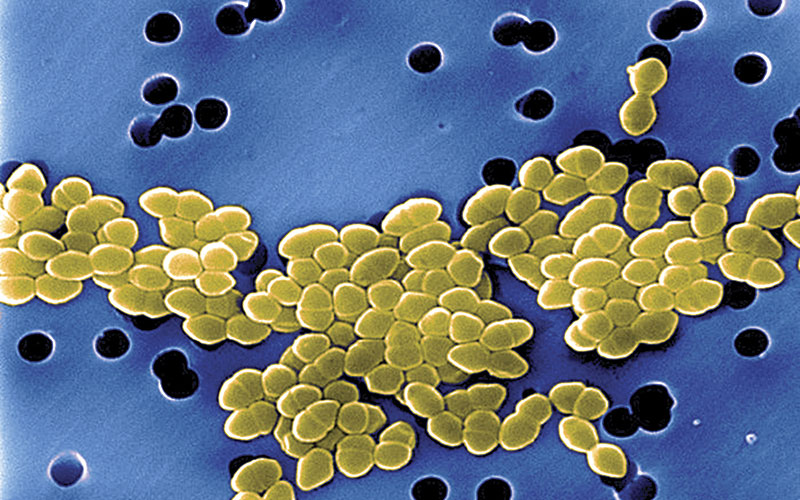Deputy Lab Manager Francis Yongblah looks at unexpected detection of vancomycin-resistant enterococci as a consequence of enhanced carbapenem-resistant Enterobacteriaceae screening.

Great Ormond Street Hospital (GOSH) is a tertiary paediatric centre with 268,000 patient visits per year, from a global patient demographic. Within paediatric patients, infection with vancomycin-resistant enterococci (VRE) has always been uncommon. Detection of colonisation of patients with VRE has also been considered to be uncommon, with only 26 cases over the last three years. For this reason, the laboratory does not screen routinely for VRE outside of specific clinical indication.
In 2015 the laboratory modified the screening protocol for admission stools to enable enhanced screening for carbapenem-resistant Enterobacteriaceae (CRE) to include the use of CARBA SMART agar (bioMeriéux). It was noticed by laboratory staff that enterococci were coming through the agar, and in January 2017 an isolate was followed up and shown to be a VRE. Further enterococcal growths were investigated and these were also found to be VRE. This shows that there may be a higher rate of colonisation of VRE within GOSH’s paediatric patient population than previously observed. It is also a possibility that there may be an unrecognised outbreak within the hospital. Determination of whether colonisation was sporadic or linked to an ongoing outbreak was important to determine appropriate infection prevention interventions. The aim of this investigation was to investigate whether VRE detected in these patients represents higher than expected “Out of GOSH” colonisation and/or arose from an unrecognised hospital outbreak.
Screening of enteric specimens
After discovering the selective properties of the CARBA SMART agar for VRE, the clinical team was informed and a decision was made by the Director of Infection Prevention and Control (DIPC) and the Infection, Prevention Control team to carry out a point prevalence study on all enteric specimens. In total, 1,500 stools were screened for VRE over three months.
Procedural steps of investigation
After it was agreed that this investigation would take place the following procedures were incorporated into the routine diagnostic work of the enteric bench:
- Culture of enteric specimen onto CARBA SMART agar
- Isolation of blue colonies
- Confirmation of identification by matrix-assisted laser desorption/ionisation-time of flight (MALDI-ToF) MS
- Antibiotic susceptibility testing for confirmation as VRE
- Typing to determine similarities and difference between patient strains.
Routine admission screen
As part of the GOSH admission screen, all enteric specimens are cultured onto MacConkey agar with a gentamicin disc and the CARBA SMART agar. Plates were incubated overnight at 37oC in O2 conditions. Plates were examined for possible carbapenemase and tiny blue colonies, which were likely to be Enterococcus, were also followed up. These tiny blue colonies were identified by Matrix Assisted Laser Deabsorption Ionisation – Time of Flight (MALDI-ToF MS).
Antibiotic sensitivity testing
Isolates that were identified and confirmed from the MALDI ToF to be Enterococcus species then went on to have antimicrobial susceptibility testing using the EUCAST methodology. Antibiotics tested against included ampicillin, gentamicin, linezolid, teicoplanin and vancomycin. Sensitivities were incubated for 24 hours at 37oC in O2 conditions. Isolates that demonstrated resistance to the vancomycin diagnostic disc then went on to have an MIC vancomycin test for confirmation of resistance.
Typing
Once isolates had been confirmed as VRE by EUCAST susceptibility disc and MIC testing isolates where referred to Public Health England to Dr Jane Turton for typing by Pulse Field Gel Electrophoresis (PFGE).
Validation against VRE chromogenic medium
A small validation was carried out to compare VRE chromogenic medium (Oxoid) to the CARBA SMART medium – 20 isolates were tested and compared on both culture media. Laboratory staff found that there was no difference in their appearance on the media and so the laboratory decided to continue to use the CARBA SMART (bioMeriéux) to screen for both CRE and VRE.
Summary of key results
Out of the 1,500 stools that were screened, 30 patients were positive for carrying VRE. Three of the patient isolates from haematology/oncology ward were linked by PFGE analysis, and two further cases were determined to be linked on a cardiac ward. Epidemiological investigation demonstrated a possible link. In total, 15 isolates were found to have unique PFGE profiles and were not considered to be linked to possible transmission events
at GOSH.
Conclusion
Intellectual curiosity demonstrated that modification of CRE screening methodologies could be used for detection of VRE. This investigation has also shown that levels of colonisation within paediatric patient populations is higher than previously thought. Systematic screening with specific detection methodologies (CARBA SMART is not designed for this purpose) may be needed to investigate the level of VRE colonisation in children attending paediatric tertiary centre for infection prevention control and empirical antibiotic policy developments. The detection of VRE through CARBA SMART has now become part of the routine protocol on the enteric bench as a way of monitoring carriage and being able to detect outbreaks. Further investigation
is currently being undertaken to compare different typing methods in particular comparing PFGE to whole genome sequencing. By comparing the two methods, it is hoped that more information can be gathered about transmission of the VRE and also identify any links between colonisation and transmission on patients.
|
Patient Number |
Ward Location |
Organism Identification |
PFGE Result |
|
1 |
Lion (Haematology) |
Enterocuccus faecium |
GREA14E-16” |
|
2 |
Lion (Haematology) |
Enterocuccus faecium |
GREA14E-16” |
|
3 |
Elephant (Oncology) |
Enterocuccus faecium |
GREA14E-16” |
|
4 |
Bear |
Enterocuccus faecium |
GREA14E-17” |
|
5 |
CICU |
Enterocuccus faecium |
GREA14E-17” |
Francis Yongblah is Deputy Laboratory Manager at GOSH. He would like to thank staff at GOSH Microbiology for their help and Dr Jane Turton at PHE Colindale for the PFGE analysis. He also acknowledges Andrew O’Sullivan, Specialist Biomedical Scientist, whose curiosity led to the discovery of the use of CARBA SMART as a medium for screening for the isolation of VRE.




